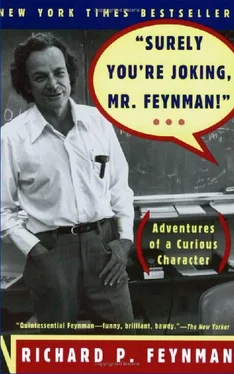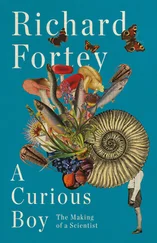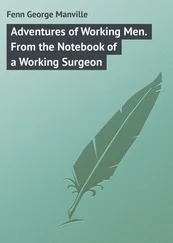It isn’t really right. First of all, as everybody knows, the paramecia, from time to time, conjugate with each other—they meet and exchange nuclei. How do they decide when it’s time to do that? (Never mind; that’s not my observation.)
I watched these paramecia hit something, recoil, turn through an angle, and go again. The idea that it’s mechanical, like a computer program—it doesn’t look that way. They go different distances, they recoil different distances, they turn through angles that are different in various cases; they don’t always turn to the right; they’re very irregular. It looks random, because you don’t know what they’re hitting; you don’t know all the chemicals they’re smelling, or what.
One of the things I wanted to watch was what happens to the paramecium when the water that it’s in dries up. It was claimed that the paramecium can dry up into a sort of hardened seed. I had a drop of water on the slide under my microscope, and in the drop of water was a paramecium and some “grass”—at the scale of the paramecium, it looked like a network of jackstraws. As the drop of water evaporated, over a time of fifteen or twenty minutes, the paramecium got into a tighter and tighter situation: there was more and more of this back-and-forth until it could hardly move. It was stuck between these “sticks,” almost jammed.
Then I saw something I had never seen or heard of: the paramecium lost its shape. It could flex itself, like an amoeba. It began to push itself against one of the sticks, and began dividing into two prongs until the division was about halfway up the paramecium, at which time it decided that wasn’t a very good idea, and backed away.
So my impression of these animals is that their behavior is much too simplified in the books. It is not so utterly mechanical or one-dimensional as they say. They should describe the behavior of these simple animals correctly. Until we see how many dimensions of behavior even a one-celled animal has, we won’t be able to fully understand the behavior of more complicated animals.
I also enjoyed watching hugs. I had an insect book when I was about thirteen. It said that dragonflies are not harmful; they don’t sting. In our neighborhood it was well known that “darning needles,” as we called them, were very dangerous when they’d sting. So if we were outside somewhere playing baseball, or something, and one of these things would fly around, everybody would run for cover, waving their arms, yelling, “A darning needle! A darning needle!”
So one day I was on the beach, and I’d just read this book that said dragonflies don’t sting. A darning needle came along, and everybody was screaming and running around, and I just sat there. “Don’t worry!” I said. “Darning needles don’t sting!”
The thing landed on my foot. Everybody was yelling and it was a big mess, because this darning needle was sitting on my foot, And there I was, this scientific wonder, saying it wasn’t going to sting me.
You’re sure this is a story that’s going to come out that it stings me—but it didn’t. The book was right. But I did sweat a bit.
I also had a little hand microscope. It was a toy microscope, and I pulled the magnification piece out of it, and would hold it in my hand like a magnifying glass, even though it was a microscope of forty or fifty power. With care you could hold the focus. So I could go around and look at things right out in the street.
So when I was in graduate school at Princeton, I once took it out of my pocket to look at some ants that were crawling around on some ivy. I had to exclaim out loud, I was so excited. What I saw was an ant and an aphid, which ants take care of—they carry them from plant to plant if the plant they’re on is dying. In return the ants get partially digested aphid juice, called “honeydew.” I knew that; my father had told me about it, but I had never seen it.
So here was this aphid and sure enough, an ant came along, and patted it with its feet—all around the aphid, pat, pat, pat, pat, pat. This was terribly exciting! Then the juice came out of the back of the aphid. And because it was magnified, it looked like a big, beautiful, glistening ball, like a balloon, because of the surface tension. Because the microscope wasn’t very good, the drop was colored a little bit from chromatic aberration in the lens—it was a gorgeous thing!
The ant took this ball in its two front feet, lifted it off the aphid, and held it. The world is so different at that scale that you can pick up water and hold it! The ants probably have a fatty or greasy material on their legs that doesn’t break the surface tension of the water when they hold it up. Then the ant broke the surface of the drop with its mouth, and the surface tension collapsed the drop right into his gut. It was very interesting to see this whole thing happen!
In my room at Princeton I had a bay window with a U-shaped windowsill. One day some ants came out on the windowsill and wandered around a little bit. I got curious as to how they found things. I wondered, how do they know where to go? Can they tell each other where food is, like bees can? Do they have any sense of geometry?
This is all amateurish; everybody knows the answer, but I didn’t know the answer, so the first thing I did was to stretch some string across the U of the bay window and hang a piece of folded cardboard with sugar on it from the string. The idea of this was to isolate the sugar from the ants, so they wouldn’t find it accidentally. I wanted to have everything under control.
Next I made a lot of little strips of paper and put a fold in them, so I could pick up ants and ferry them from one place to another. I put the folded strips of paper in two places:
Some were by the sugar (hanging from the string), and the others were near the ants in a particular location. I sat there all afternoon, reading and watching, until an ant happened to walk onto one of my little paper ferries. Then I took him over to the sugar. After a few ants had been ferried over to the sugar, one of them accidentally walked onto one of the ferries nearby, and I carried him back.
I wanted to see how long it would take the other ants to get the message to go to the “ferry terminal.” It started slowly but rapidly increased until I was going mad ferrying the ants back and forth.
But suddenly, when everything was going strong, I began to deliver the ants from the sugar to a different spot. The question now was, does the ant learn to go back to where it just came from, or does it go where it went the time before?
After a while there were practically no ants going to the first place (which would take them to the sugar), whereas there were many ants at the second place, milling around, trying to find the sugar. So I figured out so far that they went where they just came from.
In another experiment, I laid out a lot of glass microscope slides, and got the ants to walk on them, back and forth, to some sugar I put on the windowsill. Then, by replacing an old slide with a new one, or by rearranging the slides, I could demonstrate that the ants had no sense of geometry: they couldn’t figure out where something was. If they went to the sugar one way and there was a shorter way back, they would never figure out the short way.
It was also pretty clear from rearranging the glass slides that the ants left some sort of trail. So then came a lot of easy experiments to find out how long it takes a trail to dry up, whether it can be easily wiped off, and so on. I also found out the trail wasn’t directional. If I’d pick up an ant on a piece of paper, turn him around and around, and then put him back onto the trail, he wouldn’t know that he was going the wrong way until he met another ant. (Later, in Brazil, I noticed some leaf-cutting ants and tried the same experiment on them. They could tell, within a few steps, whether they were going toward the food or away from it—presumably from the trail, which might be a series of smells in a pattern: A, B, space, A, B, space, and so on.)
Читать дальше












